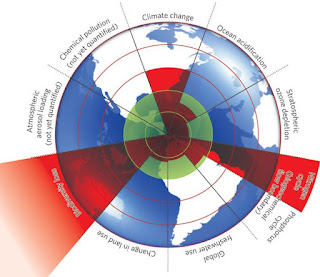The Age of Sustainable Development
The Age of Sustainable Development
by Jeffrey D. Sachs
Main Points:
 |
| Johan Rockstrom's 2009 Nature diagram on a Safe Operating Space for Humanity |
- Anthropocene: We have left the Holocene, the period 10,000 years ago when agriculture got started until now. We are in a new geological epoch. Paul Krudsen coined this term and might have meant it as a metaphor that humanity had become so large that it could change the planet. If you apply the same criteria to the end of former epochs, would you say that we are in a new era? The answer is yes.
- Three events about 43 years ago made an impact: (1) UN Conference on Environment and Development in Stockholm (2) Publication of 'Limits to Growth' and it is possible to overshoot the Earth's ecosystem (3) Jeffrey Sachs joined Harvard as a freshman.
- Central component of the Industrial Revolution- it was the ability for the mega-transformation of energy. All work that we can do in the world- construction or running spinning Jenny's requires energy. The trees of England was not enough and coal became the key to the modern world. The steam engine was the moment of transformation. This is why we have the Anthropocene.
- Angus Madison's estimates on per capita income : we have two orders magnitude of the world economy, one order of magnitude of the world's population.
- In 1824 we began to know with Fourier. In the 1860's we learned about the greenhouse effect and the spectral absorption of CO2. 1896, Svante Arrhenius worked out in paper and pencil what a doubling in CO2 would do - raise temperatures by 3 degrees Celsius.
- Technological transformation due to connectivity/information has a huge potential to address inequality and sustainable development. Shenzhen was 23,000 farmers in 1980 and is now 23 million in a metropolitan area.
- What is sustainable development? Development that is socially inclusive and environmentally sustainable. There are several reasons why we are not achieving this:
- Economic Development
- Least Developed Countries fall in the tropics and are mainly landlocked (poor trade).
- Gini Coefficient: a measure of income inequality
- Human Development Index (HDI): a measure of the happiness as weighted by economics, health, and education
- Broad-based Social Inclusion
- Environmental Sustainability
- Good Governance
- What large goals were signed in 2015?
- UN Framework Meeting: Adopting Sustainable Development Goals (SDG's)
- Paris Climate Accord: Reach an agreement on the 2 degree Celsius rise
- Addis Ababa Summit: Reaching and understanding on financing renewable energy
- Large systematic changes
- Energy systems that move from high carbon world to low-carbon world
- Resilient and sustainable agriculture
- Smart urban systems (ICT-based) because it will be 70% urban by 2030.
- Better health education/governance
- Directed technical change
- US spending on health is about $30 billion/ year
- US spending for renewable energy technology is about $3 billion/year
- Does investment work? NIH deciphered the Human Genome Project for several billion dollars, and they wanted to reduce the cost from $100 million/genome to $1,000. It took 13 years for this to happen.
- Jeffrey Sachs says he is a Social Democrat- capitalism can exist in a productive manner (like Sweden, Norway, and Denmark are examples of this). Have had struggles with immigrant populations and other issues, but are examples of capitalism that works for society, inclusion, and attention to environment. Scandinavian countries rank high on the World Happines Report.
- What are the Sustainable Development Goals?
- Goal #1: Eliminating Extreme Poverty/Hunger (Millennium Development Goals)
- Goal #2: Achieve development within Planetary Boundaries
- Goal #3: Ensure Effective Learning for all Children and Youth for Life/Livelihood
- Goal #4: Achieve Gender Equality, Social Inclusion and Human Rights for All
- Goal #5: Achieve Health and Wellbeing at All Ages of Life
- Goal #6: Improve Agricultural Systems and Raise Rural Productivity
- Goal #7: Empower Inclusive, Productive, and Resilient Cities.
- Goal #8: Curb Human-Induced Climate Change and ensure Sustainable Energy
- Goal #9: Secure Ecosystem Service and Biodiversity and ensure Good Management of Water and other Natural Resources
- Goal #10: Transform Governance for Sustainable Development
Listen to Jeffrey Sachs' lecture at the London School of Economics in 2015!
Watch the full Massive Open Online Course (MOOC) on Sustainable Development by ColumbiaLearn!





Comments
Post a Comment